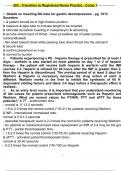Samenvatting
Summary: Marketing Models, ISBN: 9781539926108 Advanced Management and Marketing (Marketing part) (BMO21306)
- Instelling
- Wageningen University (WUR)
- Boek
- Marketing Models
This is a comprehensive summary of the subject “Advanced Management and Marketing (Marketing)”. Teaching material from the various lessons and related literature have been incorporated into it. In addition, various examples have been given as to clarify the abstract nature of some literature. ...
[Meer zien]














